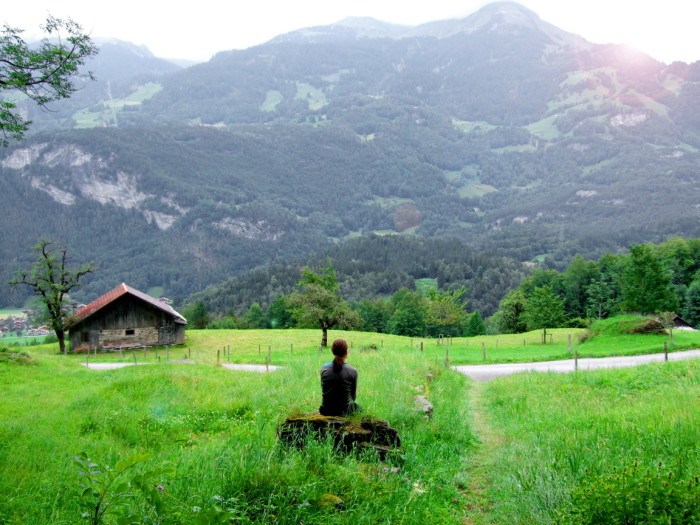Years ago, I found myself at a crossroads in my life. I knew I wanted to move forward, making positive changes to live the life I truly wanted, but I couldn’t let go of what was holding me back. I found myself in a pattern of one-step-forward, two-steps-back.
One of my life-long dreams has been to travel India. Working in a book store at this time, I read through numerous adventures of mystics, gurus, sacred cows, horrendous stomach bugs, orphans in slums, yogis in caves, and ashrams. I loved the idea of being in an Ashram. To experience solitude without distraction was truly enticing to me. If only I could sit with myself long enough, perhaps I could clearly see the path I must take.
The universe tossed me a bone the day I picked up Sarah MacDonald’s Holy Cow, and read the entertaining account of her Vipassana meditation experience: a silent retreat for ten days, meditating from four a.m. until nine p.m. I don’t think she was especially impressed, but I was. It was just what my heart was craving, and I googled “Vipassana Massachusetts.” I dove at the opportunity to be isolated in a dark closet, in silence. I signed up for the next available ten-day program, and resolved not to question my sanity.
Vipassana meditation is to find truth; to become liberated of suffering caused by the mind and the body. Vipassana originates from Theravada Buddhism, however it is not exclusive to Buddhism, since suffering isn’t either. Each course is practiced in noble silence, and every student begins with the ten day course. Along with the predictable rules that restrict drugs, sex and alcohol, there is no speaking, no gesturing, and no eye contact. The only time a student speaks is in a scheduled teacher conference. There is no yoga, no writing, no praying, and no distractions of any kind that are going to keep you from diving deep in to the depths of your honest-to-goodness soul.
To practice Vipassana is to sit and observe the body. For the first three days, from four a.m to nine p.m., the student only observes the space under the nose; simply noticing the sensation of breath moving over the upper lip. This is known as anapana meditation. I’d be a liar if I told you that it was easy. My mind scattered in a million directions, and then I’d wrangle it back to my lip. Eventually, I was led through a vipassana meditation; the sensations of the head, down the neck, the back, through the extremities, back up the front, back to the lip. Then start over. And over. And over. I observed how my clothes felt, the ground beneath me, my feet falling asleep, nagging pains in my knees, and where my heart beat. Days into this, the ligaments between my mind and body grew stronger. At meals and during sleep I flowed in a clear consciousness.
My Vipassana was taught by S.N. Goenka, a Burmese guru who taught from a cushion and a blanket. Goenka was not actually there, and he looked more like a fat, smiling Buddha than a saintly ascetic, but he was the heir to a 2,500-year-old lineage. We listened to his recorded voice at the beginning of various meditations, and watched a video of him each night. I fell in love with him after a few days. He had just what I wanted. He was so happy and completely confident in the universe. He knew he was right where he was supposed to be.
Perhaps not surprisingly, Vipassana is extremely challenging. It seemed counterintuitive at times to have nothing to distract myself with. I was desperate to get away from myself at times, driving myself nuts with fantasies of having things that I couldn’t have. I wanted to blast punk-rock music, smoke cigarettes, drink booze straight from the bottle and pop peanut M & M’s. I wasn’t so sure about this truth that was being revealed. I feared that I might like serenity; that I’d be one of those stiffs who enjoyed a wholesome, honest-to-goodness life, sans chaos and reckless abandon. I couldn’t imagine my life would be interesting without the occasional brush of danger. If I weren’t engaged in precarious behavior, I might miss something. There were moments when I felt I might be going slightly crazy, and I wanted to escape myself– other moments were bliss. The lesson in Vipassana is to come back to the self. To try not to run away from what I am.
The subject that often comes up in Buddhism is suffering. In Vipassana, we learn to experience suffering and then let it go. Eventually, the idea is to process suffering and reacting calmly, realizing that this, too, will pass.
Years later, I am benefiting from this practice that sent me on a roller coaster ride to truth. If I didn’t have young children, I would sign up for another ten days on a cushion. It is for anyone willing to see beyond the illusions of the mind, and seeks transformation. I am forever grateful for Vipassana.
For more information on Vipassana, or to sign up for a course near you, visit this website.
Also by Jessica Riley-Norton: Could You Have Candida Overgrowth?
Related: I Tried It: Zen Meditation Sangha
__
Photo: Jacek NL via Flickr





